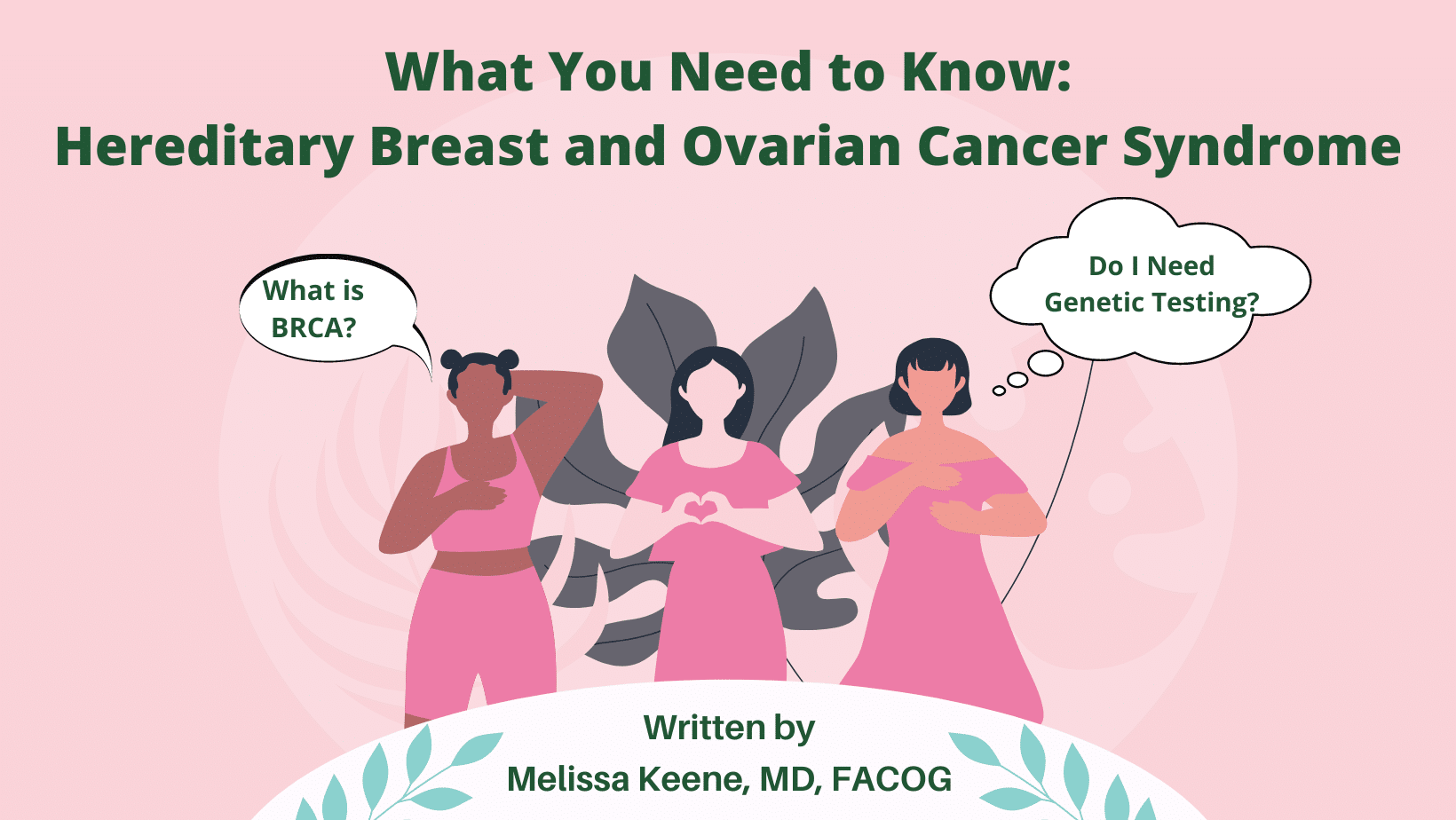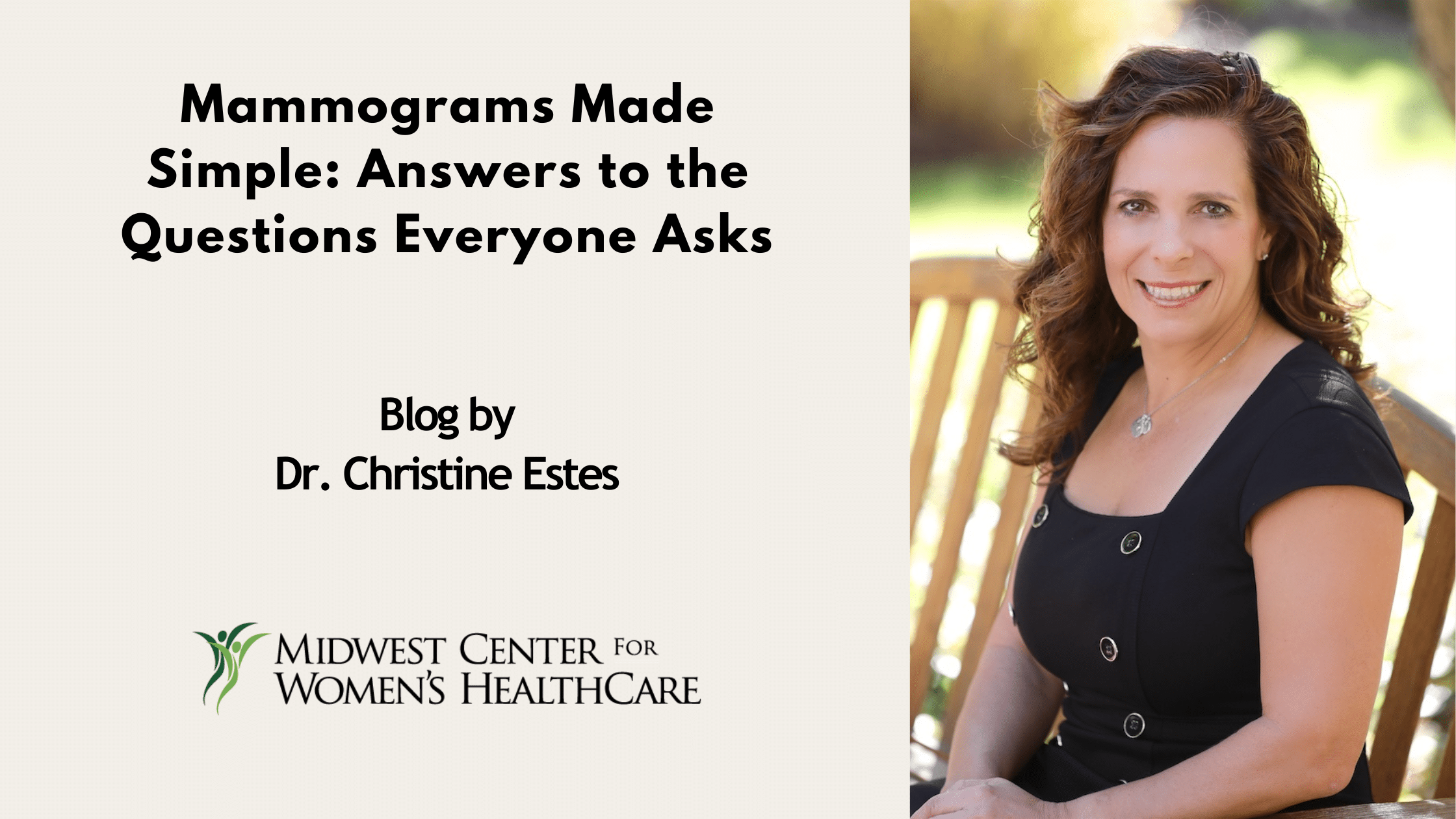Hereditary Breast and Ovarian Cancer Syndrome (HBOC)
Hereditary breast and ovarian cancer-susceptibility syndrome (HBOC) occurs when multiple family members are diagnosed with breast, ovarian, fallopian tube and/or primary peritoneal cancer. In many cases, this can mean there is a genetic mutation (a permanent change in one’s DNA) that predisposes individuals to these specific cancers. Mutations in the BRCA1 and BRCA2 genes are responsible for most of these cases, but there are several other genes that also place patients at increased risk. The name “BRCA” stands for BReast CAncer gene. It is estimated that 9-24% of ovarian cancers and 4.5% of breast cancers are due to BRCA1 and 2 mutations. Other common mutations include Lynch Syndrome, RAD51C, RAD51D and STK11. Lynch Syndrome is known for increasing the risk of ovarian, uterine and colon cancers.

Risk of Breast Cancer
The risk of breast cancer with a BRCA1 or BRCA2 mutation is 45-85% by 70 years of age! A woman with a more aggressive triple-negative breast cancer is also much more likely to carry a BRCA1 mutation. This means the cancer does not respond to hormonal treatment options and is more difficult to treat.
Risk of Ovarian Cancer
For a BRCA1 mutation, the risk of ovarian cancer (including fallopian tube and primary peritoneal) is 39-46% by age 70. For BRCA2, the risk is 10-27%. In Lynch Syndrome, the lifetime risk of ovarian cancer can be as high as 38%. There are many different types of ovarian cancer. Epithelial ovarian cancer is the type most frequently associated with these mutations.
Risk of Other Cancers
Patients with BRCA mutations are also at risk for pancreatic, melanoma, uterine cancer (BRCA1 only) and prostate cancer (males only). BRCA2 carriers have a 7% lifetime risk of pancreatic cancer. The risk of uterine cancer can be as high as 71% in Lynch Syndrome.
Who should be offered genetic testing?
Any patient that meets the following criteria should strongly consider genetic testing:
- Personal history of epithelial ovarian, fallopian tube, or peritoneal cancer
- Personal history of breast cancer at ≤ 45 years of age
- Personal history of breast cancer and have a close relative with breast cancer at ≤ 50 years of age or close relative with epithelial ovarian, fallopian tube, or peritoneal cancer at any age
- Personal history of breast cancer at ≤ 50 years of age with a limited or unknown family history
- Personal history of breast cancer and have two or more close relatives with breast cancer at any age
- Personal history of breast cancer and have two or more close relatives with pancreatic cancer or aggressive prostate cancer
- Two breast cancer primaries, with the first diagnosed before age 50
- Triple-negative breast cancer at age ≤ 60
- Breast cancer and Ashkenazi Jewish ancestry at any age
- Personal history of pancreatic cancer and have two or more close relatives with breast, ovarian, fallopian tube, peritoneal, pancreatic or aggressive prostate cancer
Women unaffected with cancer, but with one or more of the following should also receive genetic counseling and be offered genetic testing:
- A first-degree or several close relatives that meet one or more of the above criteria
- A close relative carrying a known BRCA1 or BRCA2 mutation
- A close relative with male breast cancer
How is genetic testing performed?
For patients that meet criteria, it is generally recommended to undergo next-generation multigene panel testing. This means testing for several genes in addition to BRCA1/2 including CHEK2, PALB2, and ATM to name a few. The testing can be performed using blood, saliva or buccal (cheek) cells. We do not routinely recommend direct-to-consumer BRCA1/2 testing with at-home kits. These companies only test for the 3 most common mutations and can provide false reassurance. Patients that received genetic testing before 2013 should also consider repeating their testing as more genes are now available on the panel.
In the United States, most insurance companies cover 90% or more of the costs in appropriate candidates. A common reason for declining genetic testing can also be fear of genetic discrimination. Fortunately, there are laws in the United States at the federal and state level that provide protection against such discrimination.
Population-based testing: Ashkenazi Jewish
It is estimated that 1 in 40 individuals of Ashkenazi Jewish descent will carry a BRCA mutation. Because of this, there is consideration that these individuals should be offered genetic testing even without a direct family history of cancer.
Options for surveillance and prevention
If you are found to carry a mutation, we do recommend regular surveillance with our healthcare team.
Breast Cancer
- Monthly breast self-examinations, beginning at age 18
- Clinical breast examinations performed twice a year by a healthcare provider, beginning at age 25
- Yearly MRI scans of both breasts, between ages 25 and 29.
- Yearly mammogram and breast MRI, between ages 30 and 75.
- Consideration of tamoxifen use in female BRCA2 carriers that opt against mastectomies. Tamoxifen is a hormone blocking pill that can reduce breast cancer by up to 50% if taken for 5 years in high-risk women. It is less helpful in BRCA1 carriers as they are more likely to have breast cancer that is hormone receptor negative, meaning it does not respond to tamoxifen.
Ovarian Cancer
- Pelvic ultrasound (performed with a vaginal probe) and serum CA-125 (a blood test that is elevated in ovarian cancer) every 6 months starting at age 30. Unlike mammogram and MRI, there is NOT high-quality evidence that this reduces ovarian cancer mortality or results in earlier stage at diagnosis. Thus, some patients may choose to forego this screening. For other patients, it can be a reasonable option until they undergo preventative surgery.
- Oral contraceptive pills have been shown to significantly reduce the risk of both ovarian and fallopian tube cancers. The largest study to date demonstrated a 5% decreased risk of ovarian cancer for each year of use. Oral contraceptive pills have also not been found to increase the risk of breast cancer in BRCA carriers.
Surgical risk-reduction
Breast Cancer
- All mutation carriers should be offered prophylactic mastectomies. This means removal of breast tissue before cancer develops.
Ovarian Cancer
- BRCA1/2 carriers are recommended to undergo bilateral salpingo-oophorectomy by age 35-40. This means removal of both ovaries and fallopian tubes. BRCA2 carriers may consider delaying surgery until age 40-45 as they tend to be slightly older at age of cancer diagnosis. Patients with Lynch Syndrome should undergo removal of their uterus and ovaries once childbearing is completed.
- Bilateral salpingo-oophorectomy (BSO) has also been shown to decrease the risk of breast cancer in some mutation carriers if a patient undergoes surgery BEFORE the natural age of menopause
- Some patients may choose to first undergo removal of their fallopian tubes and then delay removal of their ovaries until they are menopausal. This is not considered standard of care and does not carry the same risk-reduction but may provide some benefit in patients that would otherwise avoid any surgery. The rationale behind this approach is that there is some evidence to suggest ovarian cancer starts in the fallopian tube. Further study is needed to determine if this approach can be used long-term.
After removal of ovaries, patients should discuss with their provider the option for hormone replacement therapy to help menopausal symptoms. This can also provide protection against the development of osteoporosis. Some women may also choose to have their uterus removed to simplify hormone replacement regimens and potentially reduce uterine cancer risk.
Fertility Implications
In patients with HBOC, there is the option to reduce the risk of a future child carrying the mutation. They can undergo in vitro fertilization (IVF) along with preimplantation genetic diagnosis (PGD). Embryos that carry the mutation are not transferred during the IVF process. PGD is utilized for many different genetic hereditary syndromes. As there are physical, emotional, and financial factors to consider with IVF and PGD, this is a personal decision that should be discussed further with your healthcare provider and a reproductive endocrinology and infertility specialist.
Follow-up care
If you have any questions related to genetic testing and hereditary breast and ovarian cancer syndromes, be sure to speak with your healthcare provider. We are always happy to provide more resources along with preventative surgery consultations with our Midwest Center for Women’s Healthcare team!
References
- Hereditary breast and ovarian cancer. Cancer.Net. (2021, July 15). Retrieved October 30, 2021, from https://www.cancer.net/cancer-types/hereditary-breast-and-ovarian-cancer.
- Hereditary breast and ovarian cancer syndrome. ACOG Practice Bulletin 182, September 2017. Retrieved October 30, 2021, from https://www.acog.org/clinical/clinical-guidance/practice-bulletin/articles/2017/09/hereditary-breast-and-ovarian-cancer-syndrome.
- Isaacs C, Peshkin B. Cancer risk and management of BRCA1/2 carriers without cancer. Retrieved October 30, 2021, from https://www.uptodate.com/contents/cancer-risks-and-management-of-brca1-2-carriers-without-cancer.
- National Comprehensive Cancer Network. NCCN Clinical Practice Guidelines in Oncology. Genetic/familial high-risk assessment: Breast and ovarian. Retrieved October 30, 2021, from https://www.nccn.org/professionals/physician_gls/pdf/genetics_bop.pdf
About The Author
MELISSA KEENE, M.D., F.A.C.O.G
Melissa Keene, M.D., F.A.C.O.G. is Board-Certified in Obstetrics and Gynecology and a Fellow in the American College of Obstetrics and Gynecology. She joined our practice in 2019 after spending five years on faculty at Northwestern Memorial Hospital. Dr. Keene graduated from Northwestern University Feinberg School of Medicine and completed her residency training at Northwestern Memorial Hospital.
Dr. Keene is passionate about the management of patients with hereditary breast and ovarian cancer syndromes, minimally invasive gynecologic surgeries, advanced maternal age and exercise in pregnancy, and compassionate transgender care.
In her spare time, Dr. Keene loves spending time with her husband and 3 children. She also enjoys practicing yoga and is an avid reader.
Dr. Keene sees patients in her Evanston and Glenview offices. She is currently accepting new patients by calling 847-869-3300. Learn more about her here.





